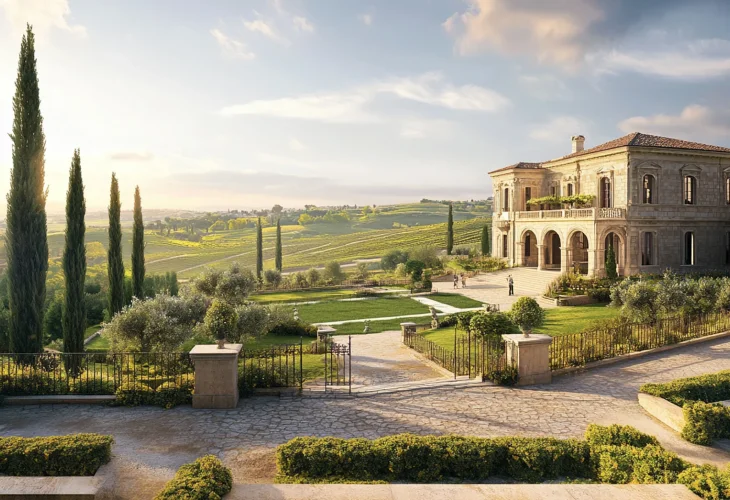History and Archaeology
The Rothschild Legacy: How One Blessing Shaped Israel’s Landscape
From Mayer Rothschild’s humble beginnings to Baron Edmond’s generosity, the Rothschild family helped establish towns, vineyards, and communities across the Land of Israel

What connects these Israeli towns: Pardes Hana, Zikhron Yaakov, Binyamina, Givat Ada, Bat Shlomo, Ashdot Yaakov, Meir Shfeya, Mazkeret Batya, Sde Eliezer, and Shadmot Dvora?
They are, of course, all located in Israel. But what makes them truly special is their shared link to Jewish history and to one family, the Rothschilds.
The story begins more than 270 years ago. In 1755, a Jewish man named Anschel Moshe Hahn passed away, leaving behind a 12-year-old son, Mayer Anschel. Mayer had been studying in the yeshiva of Fürth but was now forced to support himself. He found work as a servant in the home of Rabbi Tzvi Hirsch of Chortkov, father of the author of the Hafla’ah.
One day, a large sum of money went missing from the Rabbi’s house. Suspicion fell on the orphan servant, Mayer. When confronted, Mayer chose to repay the missing amount, even though it meant losing his job. Later, the real thief was caught, and Rabbi Tzvi Hirsch realized his mistake. Deeply moved, he gave young Mayer a heartfelt blessing: that he would one day achieve great wealth and success.
That blessing came true. Mayer Anschel prospered in business, became an expert in coins, and founded the first modern bank in Europe. He settled in Frankfurt in a house marked by a red roof, and from this “red shield” came the family name “Rothschild.”
During the Napoleonic Wars, a minister entrusted Mayer with a huge fortune, hidden in wine barrels in his cellar to avoid French soldiers. After the war, Mayer returned the entire sum honestly, earning great respect. Wilhelm I then appointed him to handle royal loans, giving him wealth and influence.
When Mayer Anschel passed away, his fortune was divided among his sons, each of whom became wealthy and influential. Their descendants continued to grow the family’s fortune, and the Rothschild name became famous across Europe for riches and generosity. They supported Jewish communities generously, giving much of their fortune to help fellow Jews.
Mayer’s son Nathan Mayer Rothschild settled in England, marrying the sister-in-law of the great Jewish philanthropist Moses Montefiore. Nathan became famous for his financial brilliance. At the Battle of Waterloo, seeing the tide turn, he rushed to Hamburg, boarded a fast ship to England, and reached the London Stock Exchange before official news arrived. Buying government bonds when prices were low, he made a fortune when word of victory spread and prices soared.
But among all the Rothschilds, one stands out in Jewish memory—Baron Edmond de Rothschild, known in Israel as HaNadiv HaYadu’a, “The Famous Benefactor.” He poured his wealth into supporting Jewish life in the Land of Israel, helping to establish towns, vineyards, and communities. Many places in Israel still carry names honoring his family:
Zikhron Yaakov – named for his father, James (Yaakov) Rothschild.
Mazkeret Batya – named for his mother, Batya Rothschild.
Meir Shfeya – named for Mayer Anschel Rothschild.
Bat Shlomo – for Batya Rothschild and in honor of her father, Shlomo Rothschild, who founded the Austrian branch of the family.
Binyamina – named after the Baron himself, whose Hebrew name was Binyamin.
Givat Ada – honoring his wife, Ada.
Shadmot Dvora – named after his daughter, Dvora.
Pardes Hana – named after Nathan Mayer’s wife, Hana Rothschild, known as the Countess of Rosebery, the wealthiest woman in England of her time.
Near Zikhron Yaakov lies the beautiful Ramat HaNadiv park, established as a mausoleum for Baron Edmond and his family. The site is surrounded by stunning gardens and nature reserves, visited by countless people every year.
From one mitzvah, the decision of a young orphan to repay stolen money and receive a rabbi’s blessing, emerged not only one of the wealthiest families in Europe, but also the creation of entire towns in the Land of Israel.

